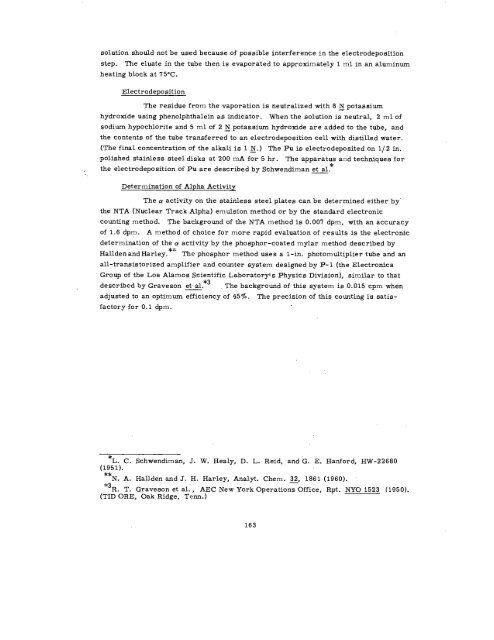THE RADIOCHEMISTRY OF PLUTONIUM - Sciencemadness.org
THE RADIOCHEMISTRY OF PLUTONIUM - Sciencemadness.org
THE RADIOCHEMISTRY OF PLUTONIUM - Sciencemadness.org
You also want an ePaper? Increase the reach of your titles
YUMPU automatically turns print PDFs into web optimized ePapers that Google loves.
..<br />
solution should not be used because of possible interference in the electrodeposition<br />
step. The eluate in the tube then is evaporated to approximately 1 ml in an aluminum<br />
heating block at 75°C.<br />
Electrodeposition<br />
The residue from the vaporation is neutralized with 8 ~ potassium<br />
hydroxide using phenolphthalein as indicator. When the solution is neutral, 2 ml of<br />
sodium hypochlorite and 5 ml of 2 N potassium hydroxide are added to the tube, and<br />
—<br />
the contents of the tube transferred to an electrodeposition cell with distilled water.<br />
(The final concentration of the alkali is 1 ~.) The Pu is electrodeposited on 1/2 in.<br />
polished stainless steel disks at 200 mA for 5 hr. The apparatus and techniques for<br />
the electrodeposition of Pu are described by Schwendiman et al.*<br />
Determination of Alpha Activity<br />
The a activity on the stainless steel plates can be determined either by”<br />
the NTA (Nuclear Track Alpha) emulsion method or by the standard electronic<br />
counting method. The background of the NTA method is 0.007 dpm, with an accuracy<br />
of 1.6 dpm. A method of choice for more rapid evaluation of results is the electronic<br />
determination of the a activity by the phosphor-coated mylar method described by<br />
*Xc<br />
Hallden and Harley. The phosphor method uses a 1-in. photomultiplier tube and an<br />
all-transistorized amplifier and counter system designed<br />
Group of the Los Alamos Scientific Laboratory!s Physics<br />
described by Grave son et al. *3<br />
The background of this<br />
adjusted to an optimum efficiency of 45 ~.. The precision<br />
factory for 0.1 dpm.<br />
by P-1 (the Electronics<br />
Division), similar to that<br />
system is 0.015 cpm when<br />
of this counting is satis -<br />
*L. C. Schwendiman, J. W. Healy, D. L. Reid, and G. E. Hanford, HW-22680<br />
(1951).<br />
**N. A. Hallden and J. H. Harley, Analy-t. Chem. ~, 1861 (1960).<br />
*3 R. T. Grave son et al. , AEC New York Operations Office, Rpt. NYO 1523 (1950).<br />
(TID ORE, Oak Ridge, Term, )<br />
163
















